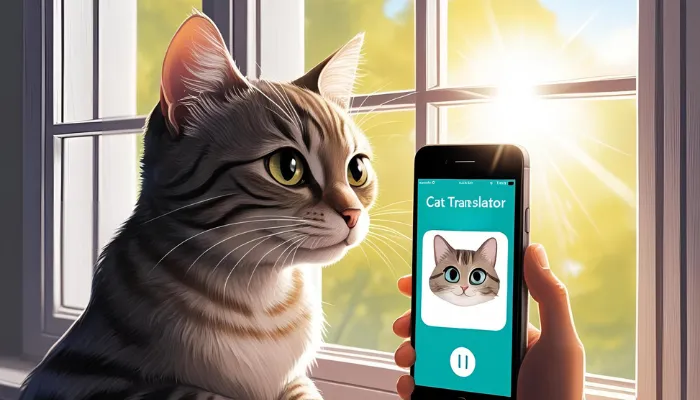The meows, purrs, and body language of your cat can feel like an entirely new language. Pet owners often ask, how to speak cat translator? While some technology has attempted to solve the mystery of what cats are trying to say with CatTranslatorApp, the secret mostly lies in the vocalizations, behaviors, and movements your cat makes. This article will help you understand your feline’s signals, take the right action, and even boost your attempts of using cat-to-human translation devices.

How to Speak Cat Translator: Turn Words into Meows
Cats communicate through meows, purrs, and body movements, each carrying a unique meaning. Understanding their dialects and context helps in decoding their emotions. Learning how to speak cat translator creates a stronger bond and mutual trust.
Before looking into details, it’s important to look into some basic parts of cat communication:
- Some of the sounds that cats use to communicate include meows, purrs and body movements.
- All cats have their own unique ‘dialects’ which consists of a particular set of sounds and actions.
- Understanding context is crucial in interpreting cat language.
- Cats also pick up human cues, making mutual understanding possible.
Learning how to speak cat translator strengthens the bond between you and your cat. Recognizing their unique sounds and actions helps in better communication. Paying attention to context makes understanding their language easier.
Understanding Cat Sounds and Their Meanings
Cats use various sounds to communicate with humans and other animals. The table below explains common cat vocalizations and their meanings, helping you understand them better with a How to Speak Cat Translator.
| Cat Sound | Meaning |
|---|---|
| Meow | General communication, demand |
| Purring | Contentment, relaxation |
| Hissing | Fear, aggression |
| Chirping | Excitement, greeting |
| Growling | Warning, discomfort |
| Yowling | Distress, mating call |
| Trilling | Happy greeting, interaction |
How to Respond to Cat Sounds?
A How to Speak Cat Translator can help decode feline sounds, but understanding natural cues is key. Cats use meows, purrs, and growls to express needs—learning their meanings strengthens your bond.
- If your cat meows frequently, they might be seeking attention or food. Try responding verbally or providing what they need.
- A purring cat often signals happiness, but if they purr while showing signs of discomfort, it could indicate pain.
- Growls or hisses mean your cat feels threatened—give them space and avoid provoking them.
- Trills and chirps are friendly invitations to interact, so engage playfully.
Recognizing different cat sounds makes interactions more meaningful. How to speak cat translator helps in understanding their emotions and needs. Paying attention to their vocal cues strengthens communication. Responding appropriately builds trust and a deeper bond.

Cat Body Language: More Than Just Meows
Cats express emotions through tails, ears, and eyes, each movement holding meaning. Understanding their body language helps in recognizing their mood and intentions. Noticing these signals strengthens communication and deepens your bond.
Cats are soft and graceful creatures. Their movements and sounds reveal their feelings and needs, and a How to Speak Cat Translator can help you understand them better.
Tail Position:
- Tail held erect: Assertive and content.
A cat that walks with its tail held high indicates that it is confident and secure in its vicinity. This position is often observed when a cat is meeting an owner and when a cat is walking around its territory. A slight twitching of the tip of the tail is also seen and can indicate excitement or expectation. - Tail held erect and fanned out: Make a scared or defensive display.
A cat’s tail fluffing up is a means to trying to make itself appear larger than it is in order to ward off danger. This response is very common in cats that are frightened or genuinely startled. This is often paired with a cat that has an arched back adopting a sideways stand. It is meant to conceal the cats face and is a defensive posture to ward off any means striking fear. - Tail curled adopted position: Denotes submissiveness or fear.
With a cats tail curled around its legs there indicates they are anxious, submissive or nervous. This position relates to discomfort in a entirely new surrounding or something a lot more powerful like a dominant animal or even emotions associated with frightening sounds or new people.
Ear Movements:
- Eyes focused forward:
Cat is in a state of curiosity, or happy. As a cat’s ears are pricked up, suggesting focus, this indicates that the animal is attentive and involved within its environment. This position is very common when a cat is playing, or out for a walk. It indicates that the cat is calm and ready for social engagement. - Flattened Ears: Angry, fearful.
Ears flattened back against a cat’s head show aggression, fear, or tremendous discomfort. There might be some growling, hissing, or cowering, which suggests that the animal may attack if further assaulted. A cat may also flatten its ears when it feels anxious, trapped or angry. - Twitching Ears: Aggrieved, irritated.
Ears twitching indicates low-level rage, high-level over-exercise, or multi-tasking overload together with multiple stimuli. If a cat’s ear twitch becomes too fast or constant, it might indicate stress and irritability.
Eye Behavior:
- Slow blinking: Trust and affection.
In the feline world, the body language of cat slow blinking indicates ease and trust. A cat that slowly closes its eyes during a friendly interaction with its owner is effectively offering a kiss. You may also strengthen your bond with your cat by returning the slow blink. - Dilated pupils: Excited or Scared.
Pupils open wider than normal during high emotion situations such as fear, excitement, and playfulness. A cat’s pupils tell a story, but they are best interpreted when accompanied by other body language. Although, having large pupils while playing indicates enthusiasm, quickly dilating them during tensed actions can also show fear. Dim light can, in some cases, lead to dilation. - Gazing: Curiosity or a challenge.
A hard and unfocused gaze can indicate different emotions in different contexts. A gentle locked gaze in a casual situation may mean interest. But on the other hand, deep and robust gaze with a stiff body may indicate a challenge or sign of superiority which can also be seen when fighting over territory in cats.
Reading cat body language helps in understanding their emotions. Their tails, ears, and eyes reveal what they feel. Noticing these subtle signals improves communication. Building trust starts with paying attention to their cues.

Can You Use a Cat Translator App?
Several apps claim to function as a cat translators or human to cat translator. While they may not offer perfect translations, they can be fun tools for cat owners to mimic feline sounds and interact with their pets.
Popular Cat Translator Apps
Curious about cat translator apps and how they work? These tools claim to interpret meows and pet sounds, but their accuracy varies.
| App Name | Features | Effectiveness |
|---|---|---|
| MeowTalk | AI-based meow translation | Moderate |
| Human-to-Cat | Soundboard with cat sounds | Low |
| My Talking Pet | Converts pet sounds to text | Fun, but not accurate |
While these apps can be entertaining, nothing beats learning real feline communication techniques.
A How to Speak Cat Translator can be a fun way to interact with your pet, but real feline communication is best learned naturally. Understanding your cat’s sounds and body language strengthens your bond.
Training Yourself to Understand Your Cat
Understanding your cat starts with observing their sounds and body language. Noticing their meows, purrs, and actions helps in recognizing their needs. Using context clues and responding appropriately builds trust. Learning how to speak cat translator strengthens your connection.
If you truly want to learn how to speak cat translator, follow these steps:
- Observe and Record Your Cat’s Sounds
- Record their meows, purrs and chirps
- Note the circumstances (e.g., before meals, when playing, when alone).
- Identify patterns in vocalization.
- Watch for Context Clues
- Is your cat near their food bowl? They might be hungry.
- Are they hiding? They could be scared or unwell.
- Are they rubbing against you? This signals affection and marking territory.
- Communicate Back in Cat Language
- Slow blink at your cat—this is a sign of trust.
- Mimic their meows to see if they respond.
- Respect their space when they flatten their ears or flick their tail.
Practicing how to speak cat translator makes interactions more meaningful. Observing their sounds and body language reveals their true emotions. Responding appropriately strengthens trust and deepens your bond. Understanding their cues creates a more harmonious connection.
Common Myths About Cat Communication
Many myths about cat communication lead to misunderstandings. Cats use tail movements, meows, and body language differently than most assume. Recognizing the truth helps in interpreting their real emotions. Learning how to speak cat translator improves your connection with them.
A feline’s behavior is often misinterpreted. Here are some myths that need to be debunked:
- Myth: Cats who wag their tail are giddy.
Fact: Unlike dogs, cats flick or wag their tails when they are annoyed. - Myth: A wagging tail means a cat is happy.
Fact: Unlike dogs, cats flick or wag their tail when annoyed. - Myth: Cats meow at each other to communicate.
Fact: Adult cats primarily meow to humans, not other cats.
Knowing the truth behind cat communication prevents misunderstandings. How to speak cat translator helps in recognizing their real intentions. Paying attention to their signals improves interactions. Understanding their unique language strengthens your bond.
Creating a Stronger Bond with Your Cat
Strengthening your bond with your cat starts with understanding their needs. Paying attention to their signals and preferences helps in building trust. Learning how to speak cat translator creates a deeper connection.
You already know how to establish a bond with your cat so begin with these points:
- Spend quality time together – Play with your cat daily.
- Respect their boundaries – Let them come to you for affection.
- Provide mental stimulation – Use puzzle toys and interactive games.
- Talk to your cat – Use a gentle, reassuring tone.
- Learn their favorite spots – Some cats love belly rubs, others hate them.
Building trust takes patience and understanding. How to speak cat translator helps in recognizing their needs and emotions. Paying attention to their signals creates a stronger bond. Every interaction brings you closer to your cat.
Conclusion
How to Speak Cat Translator is more in the area of observation than it is in technology. This is the main point of the video. Even though “Cat Translator” apps can be entertaining, actual communication occurs when you are able to comprehend the noises and movements your cat makes. If you focus on the sounds, actions, and the overall behavior of your furry friend, then you can cat build a better bond with your furry friend. Start listening and responding to your cat, and you will understand it like never before!
